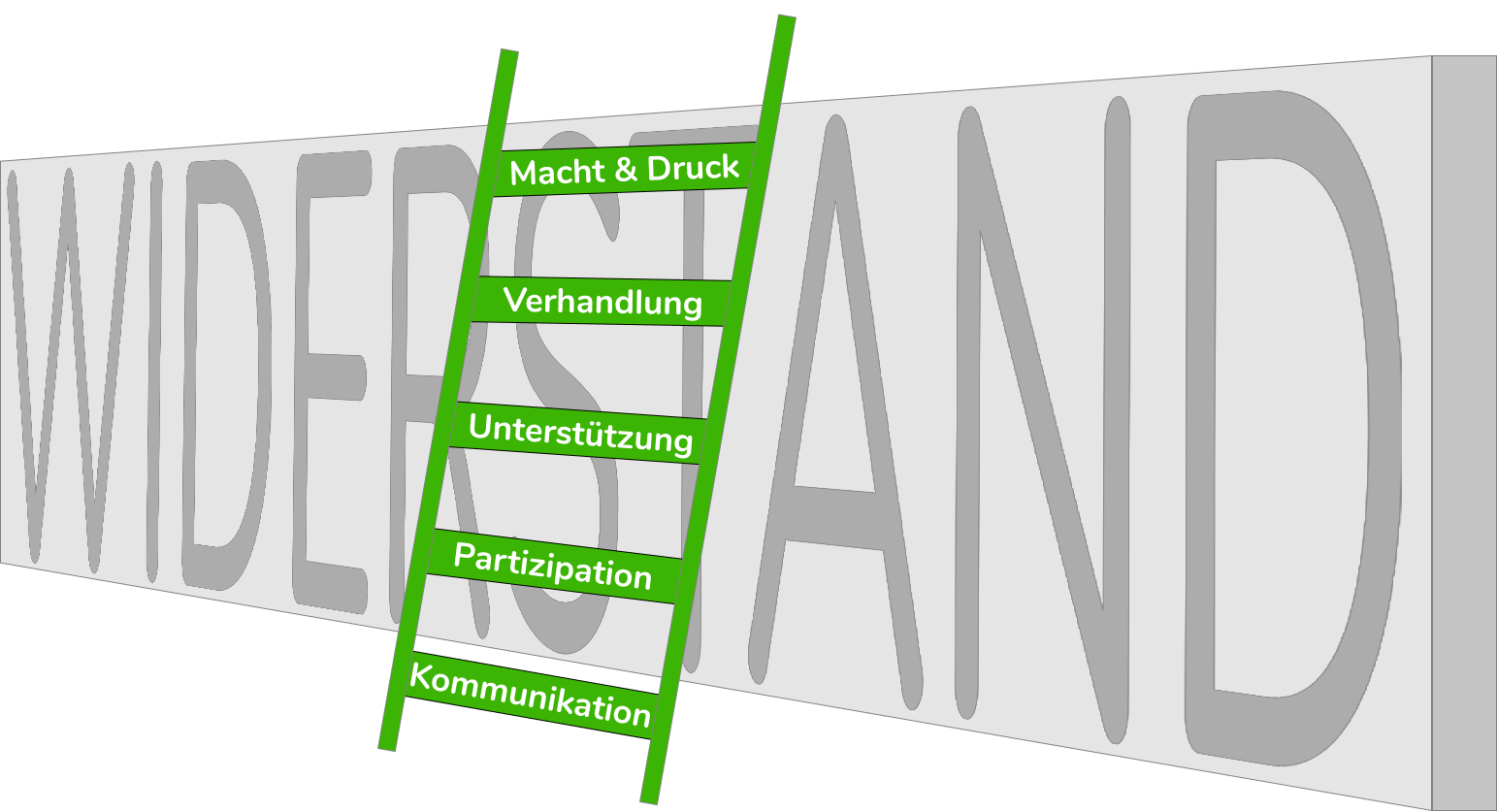In a company these days, – is almost always subject to change. Resistance – Change Management? With change, there is also resistance from employees. How should you understand resistance and what can you do about it? This article gives a brief overview.
Resistance – Change Management: Definition
Resistance – Change Management: What exactly is it? In general, the term resistance denotes the resistance to a certain thing. Resistance can take various forms. For example, resistance can be passive or active or verbal or non-verbal.
Let's take Muster AG as an example, a rather conservative production company with 400 employees. Due to the changing market environment and for employer branding reasons, it is forced to digitize itself more.

One of the biggest steps is introducing the Microsoft Suite. The reaction of the employees when they hear this: “Not another tool. Not again."
Let's go that one different types of reactions using the example by:
Resistance (active & verbal):
The employees object to the introduction of the Microsoft suite. The opinion is expressed verbally and the behavior conforms to one's own attitudes and opinions.
Excitement (active & non-verbal):
Employees in the company get upset, but do not express this verbally.
Evasion (passive & verbal):
The employees try to avoid the topic. Other, unimportant topics, for example, are addressed much more heavily than necessary.
Listlessness (passive & non-verbal):
In this case, the employees of Muster AG react with a loss of motivation, which in turn has an impact on their performance.
The following diagram summarizes various forms of expression of resistance.

Resistance – Change Management: Framework
Favor resistance
Resistance can be promoted by various aspects. More specifically, certain circumstances can encourage resistance to arise.
- the benefit of the change is generally questioned
- situational attribution for failure
- dispositional attribution for failure
That sounds very abstract at first. Let's explain the three points again using our example.
Re 1 – the benefit of the change is generally doubted
Anna, who works at Muster AG, has always worked with G-Suite and was very satisfied. She cannot understand the advantages of switching to the Microsoft suite. So she doubts the benefits of the change in general.
to 2 – situational attribution for failure
Anna is of the opinion that the introduction of the Microsoft suite should not take place at this point in time. Since there have been a lot of upheavals in the company recently, such as the switch to home office due to Corona, she doubts that another innovation would be appropriate and useful at this point.
to 3 – dispositional attribution for failure
Anna cannot imagine that Mr. Cook (manager), who initiated the change, has sufficient skills to implement it in the company. So she does not fundamentally doubt the introduction of the Microsoft suite, but rather the personal characteristics of the person responsible, as in this case, for example, Mr. Köchin's lack of social skills.
Prevent resistance
resistance can on the other hand by different conditions reduced and the willingness for the change to be increased in return. These four conditions are:
- high personal benefit
- Adequacy of change
- Support for employees
- Employee self-efficacy
Here, too, we want to explain the various aspects in more detail using our example.
to 1 – high personal benefit
Anna knows that the conversion to the Microsoft suite will automate the integration of appointments from her email inbox into her calendar. This will save her a lot of work and miscoordination can be avoided more easily.
to 2 – adequacy of change
Anna is aware that the competition has already taken the necessary steps in the course of digitization and therefore sees it as logical and necessary to switch to the Microsoft suite as well.
to 3 – support for employees
Anna feels that she is well supported by the manager throughout the change process. This support is realized through offered seminars on the Microsoft suite and also through personal discussions.
to 4 – self-efficacy of employees
Anna believes that her own skills will be enough to make the change successful. She has the feeling that her own action will also have an effect – so her self-efficacy is high. Self-efficacy is high because, when changes have been made to date, she has often received positive feedback about her role and ability to learn.

Resistance – Change Management: Commitment to Change
Resistance prevention, i.e. the creation of the framework conditions explained above, is particularly successful if the employees feel comfortable and valued in their work environment. If so, so is it Commitment, i.e. the bond and affiliation with the company, usually higher.
Commitment is an important influencing factor in connection with change processes. It has an influence on how an individual evaluates the whole or individual aspects. The commitment can also have an impact on the evaluation of the change.
As a multidimensional construct, commitment is made up of three different components, which are examined more closely below. There is affective, normative and calculatory commitment.

Affective commitment: Affective commitment includes the emotional component of a person. Belonging to the company is perceived as positive and would therefore like to be maintained. In relation to the change, this means that it is seen as useful and necessary and therefore supported.
Anna has been working at Muster AG for 21 years. She has taken her colleagues very much to her heart and simply feels at home in her team. Once she even got a month off because of a need for nursing care, although it was not legally necessary. She feels emotionally and emotionally very connected to the company and therefore shows a greater willingness to go along with the coming change.
Normative commitment: The normative commitment is based heavily on the feeling of obligation. This can arise, for example, if the company has paid the training costs for an employee or provided further training. The employee wants to give something back to the company according to the so-called principle of reciprocity, which, in relation to the change, means participating in the change.
Johannes started working at Muster AG 3 years ago. At the beginning he asked whether financed further training courses would be possible parallel to his position –, which was answered in the affirmative. For two years now, Johannes has repeatedly asked whether he can take part in various seminars, which was denied for cost reasons. Major changes and expenses can now be expected as part of the change. This makes John a little angry. He has no interest in supporting the change, as Muster AG has so far shown no willingness to support him in his further training.
Imputed commitment: The imputed commitment is strongly influenced by the perception of possible costs. It is important to avoid negative consequences as much as possible and to keep costs low. In the change process, an employee with imputed commitment would have too high a risk of resisting.
Luisa from Muster AG is not convinced of the upcoming change. Due to the lack of career alternatives and the loss of various advantages, such as her company pension, she still supports the change process.
As a result of all components of the commitment, resistance is reduced and the change is shared and supported by the employees. Affective and normative commitment, however, are the most desirable components, as they also result in high work performance.
It becomes clear that the commitment is basically an important starting point in the change process.
Is your company currently in a change? Then using our software tool could help you. It develops managers into coaches for their teams. You can take a look at the following link to see how Shopware integrates Echometer into the retro process.
Resistance – Change Management: Dealing with Resistance
Resistance can be dealt with in a number of ways. In their 2013 publication, Kotter and Schlesinger discussed various approaches to dealing with resistance.
Among other things, John P. Kotter is known for his 8-phase model of the change process. Under this link you can learn more about the topic. Another well-known one Phase model is that of Kurt Lewin.
Kotter & Schlesinger propose five approaches to dealing with resistance, which we now want to take a closer look at.

Open communication
Let's start with the open communication. If the reasons for the change are not clear to the employees or if they were not understood correctly, it is always useful to speak to the employees in more detail in order to clear up any ambiguities and to ensure that they are ready for the change to strengthen.
participation
In addition, a participation of employees to be effective. The inclusion of people who are very likely to show rebellious behavior gives them the feeling of co-determination. The employees get the feeling of being able to actively participate in the change and to partly plan the changes. A relatively “extreme” but basically very recommendable method that focuses on this is “Open Space Agility”. For more information, see right here.
Support for employees
If the employees have problems adapting to the changes after or during the implementation of the change, the Support counteract resistance from employees. This includes both professional and emotional support.
negotiation
Another way of dealing with resistance can also be negotiation be with the employees. It would be conceivable, for example, to grant veto rights for certain aspects in the change process.
Pressure and exercise of power
A final possible way of dealing with it is to reduce the resistance above Pressure and exercise of power. Such an approach can be chosen under time pressure and a quick implementation of the change. – In today's corporate cultures we strongly advise against resorting to such a method.
Ted Talk – Six keys to leading positive change
In this Ted Talk, Rosabeth Moss Kanter discusses the change process that can change the world to a certain extent. Using practical examples, she works out six key factors that she believes lead to a positive change process.
Resistance – Change Management: Conclusion
The above makes it clear that resistance is an important component in the change process. A company should be aware that change can have different manifestations and that resistance is based on. If this clarity is given, the change manager or the executive staff have the opportunity to react appropriately to resistance and to resolve it or, in the best case, to prevent it.
By the way, Muster AG has successfully managed to involve its employees and create initial success experiences in the teams with the Microsoft suite!
Sources:
- Albrecht, S. (2000). Measuring Cynicism Toward Organizational Change - One Dimension or Two ?. Journal of applied measurement, 9 (4), 374-386.
- Dudenredaktion (ed.). (Nd). Resistance. Duden online. Retrieved from https://www.duden.de/rechtschreibung/Widerstand
- Holt, D., Armenakis, A., Field, H., & Harris, S. (2007). Readiness for Organizational Change: The Systematic Development of a Scale. The Journal of Applied Behavioral Science, 43 (2), 232-255. doi: 10.1177 / 0021886306295295
- Lauer, T. (2010). Change Management: Basics and Success Factors. Berlin Heidelberg: Springer publishing house.
- Bouckenooghe, D. & Minbashian, G. (2014). Herscovitch and Meyer's Three-Component Model of Commitment to Change: Meta-Analytic Findings. European Journal of Work and Organizational Psychology. 24. doi: 10.1080 / 1359432X.2014.963059.










